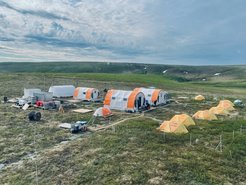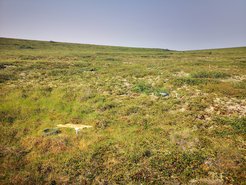Trail Valley Creek

The Trail Valley Creek research station is situated near the treeline in the continuous permafrost region of the Northwest Territories (68.74 °N, 133.50 °W), Canada. This area predominantly features low shrub or tussock tundra with some trees along the shorelines of water bodies. The soil composition mainly consists of a thin organic layer above minereal soils underlain by continuous permafrost. The average annual air temperature is around −8 °C, and the region receives an average annual precipitation of approximately 230 mm. The area experiences seasonal thawing from late May to September, leading to active layer dynamics and varying surface water conditions. During the spring thaw (late May to early June), the region often undergoes significant hydrological changes, with meltwater contributing to the rise of local water bodies and inundation of low-lying areas.
In 2022 the IPAS group installed three transects for portable flux chamber measurements, which include a total of 25 sampling locations (collars). These transects are located in two landscape features: polygonal mires and a small valley formed by a creek gulley. In each of those, the focus is placed on investigating hydrological gradients within a structured landscape, and their impact on greenhouse gas cycles. At each of these transects, we are conducting detailed measurements that include the fluxes of CO2 and CH4, as well as various soil parameters and vegetation composition.

Preliminarily results
The 2023 data from Trail Valley Creek revealed significant variation in CH4 fluxes across different elements of two polygonal mires, with the highest emissions found in trenches. Soil moisture at 12 cm depth was identified as a key factor influencing CH4 emissions. Depending on moisture levels, additional major constraints to greenhouse gas fluxes were provided by soil temperature and the presence of Carex aquatilis.
All sites from the small gulley didn’t show any significant CH4 fluxes.
The 2023 study on CO2 fluxes found a more complex pattern. Unlike CH4 fluxes, CO2 emissions did not vary significantly between different wetland elements. However, a notable difference was observed when considering moisture by vegetation type. This suggests that more permanent moisture conditions and different vegetation compositions play a significant role in CO2 fluxes.













